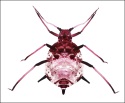Classification
Aphidinae: Aphidini
Common name(s)
Brown citrus aphid
Diagnosis
Apterae medium-sized, shiny, very dark brown to black; immature stages brown. The antennae, in addition to having much longer hairs than those of T. aurantii, are not so conspicuously black-and-white banded. Alatae with a shiny black abdomen, fore wing with a pale pterostigma, antennal segment III dark. Apterae and alatae both 1.5-2.4mm. Body 1.4-1.7x as long as antennae. Siphunculi 1.5x as long as cauda. Processus terminalis 4 -4.5x as long as base of last antennal segment. Siphunculi and cauda equally dark.
T. citricida lives in colonies on young growth of host plants, rolling leaves and stunting shoots, usually visited by ants. When disturbed, the aphids may make stridulatory movements with their hind legs, but the sound produced is not audible.
Distribution
Widespread in Africa south of Sahara, Southeast Asia, Australasia, Americas. Distributed throughout India.
Host plant(s)
Annonaceae: Artabotrys odoratissima Blume.; Rutaceae: Citrus spp., Limonia acidissima L.; Moraceae: Artocarpus incisa L. f.; Combretaceae: Terminalia catappa L.
Measurements
Aptera: Length of body 2.39, width 1.64; antennae 1.39, segments III: IV: V: VI 0.37: 0.22: 0.20: (0.09+0.39); u.r.s. 0.14; h.t.2 0.11; siphunculus 0.39; cauda 0.24.
Alata: Length of body 2.44, width 1.08; antennae 1.74, segments III: IV: V: VI 0.37: 0.33: 0.26: (0.10+0.49); u.r.s. 0.13; h.t.2 0.13; siphunculus 0.36; cauda 0.23.
Seasonal occurrence
September-October in and around Bangalore.
Natural enemies
Coleoptera: Coccinellidae: Anegleis cardoni (Weise), Cheilomenes sexmaculata (F.), Chilocorus nigrita (F.).
Hymenoptera: Braconidae: Aphidiinae: Aphidius matricariae Haliday, Lipolexis scutellaris Mackauer, Trioxys indicus Subba Rao & Sharma.
_sml.jpg)
_sml.jpg)
_sml.jpg)
_sml.jpg)
_sml.jpg)


